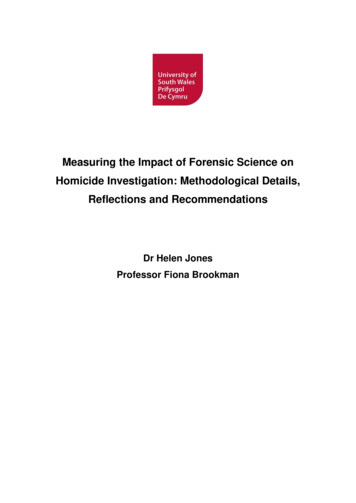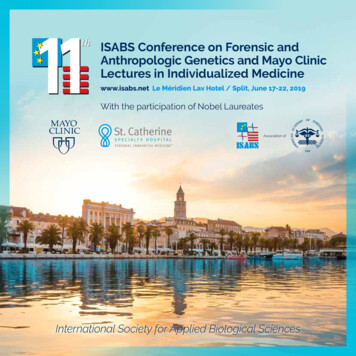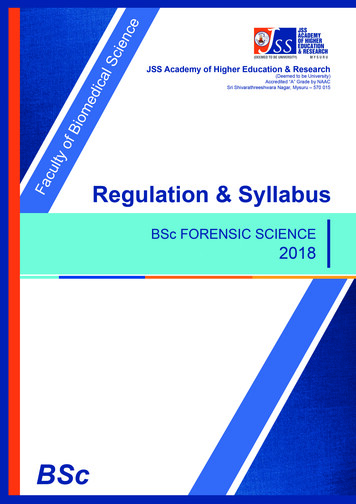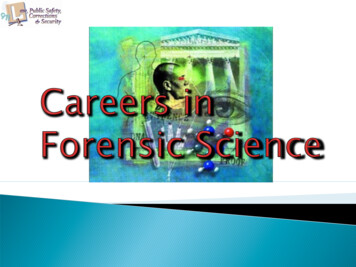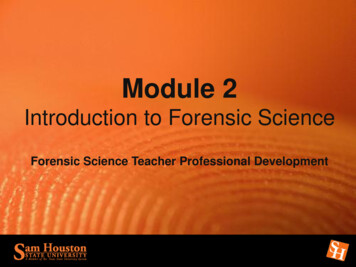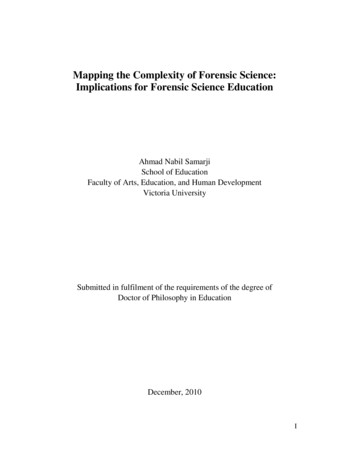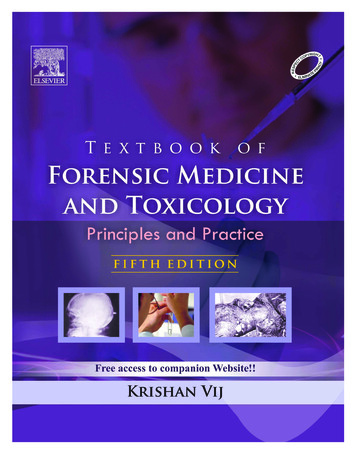
Transcription
Textbook ofForensic Medicineand ToxicologyPrelims.indd i2/9/2011 6:36:39 PM
“This page intentionally left blank"
Textbook ofForensic Medicineand ToxicologyPrinciples and PracticeFifth EditionKrishan Vij MD LLBHeadDepartment of Forensic Medicine and ToxicologyAdesh Institute of Medical Sciences & Research, Bathinda, PunjabFormer Professor and HeadDepartment of Forensic Medicine and ToxicologyGovernment Medical College and Hospital, ChandigarhCounsellorTorture MedicineELSEVIERA division ofReed Elsevier India Private LimitedPrelims.indd iii2/9/2011 6:36:40 PM
Textbook of Forensic Medicine and Toxicology, 5/eKrishan VijELSEVIERA division ofReed Elsevier India Private LimitedMosby, Saunders, Churchill Livingstone, Butterworth-Heinemann andHanley & Belfus are the Health Science imprints of Elsevier. 2011 ElsevierFirst Edition 2001Second Edition 2002Third Edition 2005Fourth Edition 2008Fifth Edition 2011All rights are reserved. No part of this publication may be reproduced, stored in a retrieval system, or transmittedin any form or by any means, electronic, mechanical, photocopying, recording or otherwise, without theprior permission of the publisher.ISBN: 978-81-312-2684-1Medical knowledge is constantly changing. As new information becomes available, changes in treatment, procedures,equipment and the use of drugs become necessary. The authors, editors, contributors and the publisher have, as far asit is possible, taken care to ensure that the information given in this text is accurate and up-to-date. However, readers arestrongly advised to confirm that the information, especially with regard to drug dose/usage, complies with currentlegislation and standards of practice.Published by Elsevier, a division of Reed Elsevier India Private Limited.Registered Office: 622, Indraprakash Building, 21 Barakhamba Road, New Delhi-110 001.Corporate Office: 14th Floor, Building No. 10B, DLF Cyber City, Phase-II, Gurgaon-122 002, Haryana, India.Managing Editor (Development): Shabina NasimDevelopment Editor: Shravan KumarManager – Publishing Operations: Sunil KumarManager – Production: NC PantTypeset by Olympus Infotech Pvt. Ltd., Chennai, India.Printed and bound at xxx, India.Prelims.indd iv2/9/2011 6:36:40 PM
Tothe memory of my daughterDivya VijPrelims.indd v2/9/2011 6:36:40 PM
“This page intentionally left blank"
ForewordIn the present civilised society, every crime ought to be punished and a criminal must be taken to task. Investigators and those whoare engaged in the dispensation of justice require aid of an expert, who, by experience and knowledge, has acquired scientific temperament and skill to unearth the crime. At the same time, with the aid of a forensic expert, an innocent can be saved from thegallows. Dr. Krishan Vij, in this edition, has put a great effort to notice transformation of medical jurisprudence to clinical forensic medicine. The present edition of Textbook of Forensic Medicine and Toxicology will be of great help not only to the under-graduateand postgraduate students but to all those who are engaged in investigation of the crime and administration of justice, be it lawyersor judges, and victims of violence and negligence.The 5th edition of Textbook of Forensic Medicine and Toxicology by Dr. Vij has summoned the resources of science from all quarters.Division of contents into segments, viz., (i) Of the Basics, (ii) Of the Dying and the Death, (iii) Of the Injured and the Injuries,(iv) Clinical Forensic Medicine, (v) Legal and Ethical Aspects of Medical Practice, (vi) Forensic Toxicology, and placement ofillustrations, tables, flowcharts, etc. speak volumes of his experience and expertise spreading over about three decades. Chapterson brain-stem death vis-à-vis organ donation; sudden and unexpected deaths; custody related torture and/or death; deaths associated with surgery, anaesthesia and blood transfusion; medicolegal examination of the living; complications of trauma (was wounding responsible for death?); medical negligence; informed consent and refusal; and medicolegal aspects of immuno-deficiencysyndrome deserve extreme applause.Exceptional features of this ensuing edition have been the presentation of cases clinching to the text and updation of informationin every segment. I am sure that the edition would serve as a guiding light for all concerned.I wish Dr. Vij all success in his endeavour.Kanwaljit Singh AhluwaliaJudgePunjab & Haryana High CourtPrelims.indd vii2/9/2011 6:36:40 PM
“This page intentionally left blank"
Preface to the 5th EditionThe rapid exhaustion of the last four editions reflects volumes of wide acceptance and popularity of the book, encouraging me tobring about the 5th edition. The current edition reflects the meticulous work that has been done to revamp its predecessor. Basedon the feedback received from students, teachers, advocates and the judiciary, both Sections of the book (Forensic Medicine andForensic Toxicology) have been extensively revised with consequent deletion of outdated information and incorporation of thenew. Extensive placement of photographs, illustrations, tables and flowcharts has made this edition extremely catchy and easyto grasp. Appearance of enormous references in the flow of the text is the result of extensive study and the period of toil andturbulence through which I had to creep in. The integral thread of evidence-based description is seen running through the entirecontent. Placement of precise information about the relevant legal provisions and forensic aspects of anatomical structures/findingsat appropriate places promote interdisciplinary understanding of issues.Cases of extreme medicolegal significance, commensurating with the flow of the text, have been introduced to illustrate medicolegal principles and explore solutions to tackle problems usually encountered in day-to-day medicolegal work. And therefore,the ensuing edition will be of immense help not only to undergraduates and postgraduates (the 'would be' medical practitioners/experts), but also to wide segments of other professionals engaged in the administration of justice; be it prosecutors, defensecounsels, and of course, the judiciary.User friendliness of the book is depicted in its lucid style, rational use of various levels of headings, subheadings and boldfacewords. Presentation of ‘cases’ is an exceptionally interesting feature of the book helping the user to have an in-depth approach tothe intricacies of medicolegal issues.Author’s view has always been that the modern time student should not be deprived of the fruits of recent information; therefore,topics like Sudden and Unexpected Deaths; Deaths due to Asphyxia; Deaths Associated with Surgery, Anaesthesia and BloodTransfusion; Custody Related Torture and/or Death; Medicolegal Examination of the Living; Injuries by Firearms; Complicationsof Trauma: Was Wounding Responsible for Death?; Medical Education via-à-vis Medical Practice; Medical Negligence; Consentto and Refusal of Treatment, etc., have been thoroughly up-dated with placement of ‘cases’ clinching to the text.In their effort to add to the learning experience, the publisher, Elsevier, has made use of this book’s companion websitehttp://www.manthan.info/Vij/web-home.aspx easy for all students. Now any student can use features like Interactive Assessment,Downloadable Images and Updates by simply logging in into the Website and creating an ID for self.In essence, the 5th edition has been nurtured with most recent information, which will serve as an excellent resource for theundergraduates as well as postgraduate students. Teachers will find it as a guiding light. A wide segment of other professionalslike practitioners (medical as well as legal), investigative agencies, and above all, the judicial officers will also be benefited withfar-reaching content of this edition.Krishan VijPrelims.indd ix3/1/2011 1:58:28 PM
AcknowledgementsRevision of any book is a gigantic task. The revision of the fourth edition would have not been possible without uninterruptedencouragement from well-wishers in general and my colleagues in particular. The acutely updated and illustrated fifth edition hasbeen made possible through rigorous and continued efforts. I am grateful to my friends and colleagues who obliged me throughhealthy discussions. While it is not possible to list them all, I record my indebtedness to:Dr. BBL Aggarwal, Ex-Principal, University College of Medical Sciences and Head of the Department of Forensic Medicine,New Delhi; for whom my vocabulary fails to locate adequate words of appreciation. An excellent teacher, guide and philosopher,he has been a source of inspiration and encouragement to me in all walks of my life.Dr. Gurpreet Inder Singh, Director Principal, AIMS&R, Bathinda (Punjab) and Dean Colleges, Baba Farid University of HealthSciences, who commands exceptional mention for his constructive and leadership qualities. Hailing from the Army Background,he has effectively been able to transmit a message of True Army Spirit at the institute as he performs and expects everything ina scheduled and meticulous manner.Dr. TD Dogra and Dr. GK Sharma, Head of the Department of Forensic Medicine, All India Institute of Medical Sciences,and Director Principal, Lady Hardinge Medical College, New Delhi, respectively, distinct and magnanimous personalities in thefield of Forensic Medicine, deserve exclusive appreciation.Earnest feeling of gratitude are expressed to the authors/writers of various books/journals/articles whose references havebeen cited in the text. Dr. JS Dalal, Dr. J Gargi, Dr. RK Gorea, Dr. Dalbir Singh, Dr. AS Thind and Dr. Jagjiv Sharma deservethanks for their constructive inputs. Dr. KK Aggarwal, Dr. SS Oberoi, and Dr. DS Bhuller invite appreciation for their interaction.Dr. Vijay Vij, my brother-in-law, who was instrumental in making me visit various libraries and book centres during my visit tothe United States of America, deserves special appreciation. I was truly amazed by his profound interest in gaining more and moreknowledge and, in fact, I happened to collect rich material from his personal library.Dr. Parmod Goyal and Dr. Vishal Garg, my colleagues at the Institute, deserve extreme applause for their inputs andcooperation.I must confess that I have been highly demanding on quality and accuracy from all staff members of Elsevier, a division ofReed Elsevier India Pvt. Ltd, sometimes rather impatiently, but all of them have been quite accommodating. In particular, I wouldlike to pen down my appreciation for Mr. Shravan Kumar, Development Editor, for his pleasant-pitched interaction with an eyeon the market placement.The users of previous editions are gratefully acknowledged for having brought the textbook at this pedestal. In the past, I havebeen benefited from suggestions by colleagues, students, advocates and the judiciary, and I urge them to continue to give theirvaluable suggestions.Before I conclude, I must acknowledge with profound gratitude, the encouragement and inspiration extended to me by wife,Anu, and my daughter, Divya (during the Herculean exercise of the maiden edition). My wife has been socially bearing the pangsof loneliness owing to my remaining obsessively occupied. Her contribution, albeit silent, is far-reaching.Krishan VijPrelims.indd x2/9/2011 6:36:41 PM
ContentsSection 1 Forensic MedicinePART IChapter 1Of the BasicsIntroduction to Forensic Medicine and Indian Legal System3Ancient traditional writings describing considerations for regulating human behaviour and providing punishments,medical ethics, and medical practice for purposes of law Explanation for the terms forensic, medicine, medicaljurisprudence, legal medicine, forensic pathology, etc. Police inquest Magistrate’s inquest Various Courts inIndia Documentary and oral evidence Exceptions to oral evidence Procedure of recording evidence Dyingdeclaration and its importance Kinds of witnesses Doctor in the witness boxChapter 2Medicolegal Autopsy, Exhumation, Obscure Autopsy, Anaphylactic Deaths and Artefacts17Clinical and medicolegal autopsy Precautions for medicolegal autopsy Objectives of medicolegal autopsy Importance of examining clothing Incisions for the autopsy Procedure for external and internal examination Selection, preservation and dispatch of viscera/specimens Exhumation Obscure autopsy Anaphylactic deaths ArtefactsChapter 3Identification35Complete and incomplete identity Corpus delicti Identification in the living Identification in the dead Primary and secondary characteristics Comparative techniques Importance of dentition in the medicolegal field Age from ‘ossification activity’ of bones Symphyseal surface in estimating age Skull sutures in estimating age Medicolegal importance of age Morphological and skeletal changes in determining sex Intersex states Stature from the bones Medicolegal information from hair, scar, tattoo mark(s), etc. Skeletal indices fordetermining sex and race Dactylography Medicolegal information from blood/blood stain Medicolegalapplication of blood groups Mass disaster Collection, preservation and dispatch of samples for DNA testing OJ Simpson casePART IIChapter 4Of the Dying and the DeathDeath and Its Medicolegal Aspects (Forensic Thanatology)74Death Presumption of death and survivorship Somatic and molecular death Brain death with its medicolegalaspects, especially in relation to organ transplantation Suspended animation Mode, manner, mechanism andcause of death Estimation of ‘time since death’ from the immediate, early and late changes after death, andfactors influencing such changes Medicolegal aspects of immediate, early and late changes after death Differentiation between postmortem staining and bruising, hypostasis and congestion, rigor mortis and cadavericspasm, rigor mortis and conditions simulating rigor mortis, etc. Postmortem damage by predators Entomologyof the cadaver and postmortem intervalChapter 5Sudden and Unexpected Death100Concept of ‘sudden’ and ‘unexpected’ death Morbid anatomy of heart and its blood supply Types of occlusion Sequelae of coronary occlusion Approaching the cause of death Postmortem demonstration of myocardialinfarction Hypertensive heart disease and sudden death Epilepsy as a cause of unexpected death Pulmonaryembolism Vagal inhibition and sudden death Sudden death in infancyPrelims.indd xi2/9/2011 6:36:41 PM
xii ContentsChapter 6Asphyxial Deaths110Asphyxia and its types Asphyxial stigmata Suffocation and its types Medicolegal aspects of carbon monoxideand carbon dioxide Medicolegal aspects of smothering, gagging, choking, traumatic asphyxia, burking, etc. Mechanism of death by compression of the neck Types, cause of death, autopsy findings and the circumstancesof hanging Types, cause of death, autopsy findings and circumstances of strangulation Mugging, garroting,bansdola, palmar strangulation, etc. Types, mechanism of death, cause of death, pathophysiology, and diagnosis ofdeath in drowning Floatation of body in water Circumstances of drowningChapter 7Infanticide and Foeticide146Infanticide and the related law Primary and secondary issues to be resolved in relation to infanticide Age ofviability and its medicolegal significance Concept of live birth and separate existence Proof of live birth Hydrostatic test and its importance Other tests for separate existence Probable duration of life of the child Autopsy Cause of death, i.e. acts of commission and acts of omission Foeticide Abandoning of children andconcealment of birth Development of foetusChapter 8Thermal Deaths159Heat regulation, systemic hyperthermia (heat cramps, heat exhaustion and heat stroke) Character of burns producedby various agents Different classification of burns Rule of nine Causes of death in burn Nature of burninjury in the absence of death Age of burn injury Autopsy findings Medicolegal aspects of death due to burns Antemortem and postmortem differentiation of burns Some legal provisions in relation to dowry death Scalds and their medicolegal aspects Differentiation of injuries due to dry heat, moist heat and chemicals Pathophysiology of hypothermia Circumstances of injury due to cold Autopsy findings in death due to coldChapter 9Starvation and Neglect173Starvation and its types Autopsy findings Circumstances of death MalnutritionChapter 10Death by Electrocution175Types of fatal electrocution Factors influencing effects of electricity Mechanism of death Autopsy findingsin ‘medium-tension’ and ‘high-tension’ currents Joule burn (endogenous burn) Circumstances of electrocution Iatrogenic electrocution Judicial electrocution Lightning and mechanism of injury by it Circumstances oflightningChapter 11Deaths Associated with Surgery, Anaesthesia and Blood Transfusion183Surgical intervention Respiratory embarrassment Cardiac embarrassment Regional and spinal anaesthesia Instruments and instrumentation Unforeseeable problems Precautions for autopsy The autopsy Medicolegalconsiderations Blood transfusion—hazards and risks Periprocedural complications, etc.Chapter 12Custody Related Torture and/or Death191Meaning of custody and torture Methods of torture Circumstances of death Related cases Role of autopsysurgeon Incisions at autopsyPART IIIChapter 13Of the Injured and the InjuriesInjuries: Medicolegal Considerations and Types197Wound, trauma, injury, etc. Mechanism of production of mechanical injuries Differentiation betweenantemortem and postmortem wounds Wound healing Important Sections of IPC relating to offences againstthe human body Simple, grievous and dangerous injuries Classification of injuriesPrelims.indd xii2/9/2011 6:36:41 PM
Contents xiiiChapter 14Injuries by Blunt Force213Forensic aspects of the anatomy of skin Abrasion and its types Patterned abrasions Fate of an abrasion Differentiation between antemortem and postmortem abrasions Medicolegal aspects of abrasions Bruise(contusion) and factors influencing its production Migratory/ectopic bruising Fate of a bruise Patternedbruising Differentiation between antemortem and postmortem bruising Medicolegal aspects of bruising Lacerations and its types Incise-looking wounds Features of lacerations Differentiation between antemortemand postmortem lacerations Medicolegal aspects of lacerationChapter 15Injuries by Sharp Force225Incision/cut/slash, etc. Features of incised wounds Bevelled cuts Hesitation cuts Chopping wounds Types and features of stab wounds Factors influencing size, shape and configuration of stab wounds Injuriesby blunt penetrating/dull instruments Wounds by glass Pointers towards suicide/accident/homicideChapter 16Injuries by Firearms234Types of firearms Types of ammunition Parts of cartridge and their functions Mechanism of bullet woundproduction Characters of wounds produced by rifled and smoothbore firearms Exit wounds by rifled andsmoothbore weapons Direction of fire Unusual circumstances in firearm injuries Various tests for firearmresidues Autopsy in firearm fatalities Suicide, accident or homicideChapter 17Injuries by Explosives266Mechanism of production of injuries by bomb blast Autopsy in explosion fatalities Medicolegal considerationsin explosion injuriesChapter 18Regional Injuries270Injuries of the scalp including forensic aspects of anatomy of the scalp Fractures of the skull including forensicaspects of anatomy of the skull Mechanism of production of skull fractures Meningeal haemorrhages withtheir medicolegal aspects Mechanism of production of cerebral injuries Medicolegal aspects of coup andcontrecoup injuries Concussion Head injuries in boxers Spinal injuries with their medicolegal aspects Facial,cervical, thoracic and abdominal traumaChapter 19Transportation Injuries296Mechanism of vehicular injury Pattern of injuries to the driver, front-seat occupants and rear-seat occupants ofa motor car Pattern of injuries to the pedestrians, motor cyclists and pedal cyclists, etc. Aircraft accidents,railway accidents and vehicular conflagration Medicolegal aspects of transportation injuriesPART IVChapter 20Clinical Forensic MedicineMedicolegal Examination of the Living304Clinical forensic medicine Medicolegal examination of the victim of assault and extending opinion Classification ofsexual offences Meaning and scope of the offence of ‘rape’ with particular emphasis on implications of consent/nonconsent Medicolegal examination of the victim and of the alleged accused of rape and extending opinion in eithercase Medicolegal examination in ‘unnatural sexual offences’ and extending opinion Medicolegal aspects of ‘semen’ Acid phosphatase test and its medicolegal importance Medicolegal importance of pregnancy Presumptive,probable and positive signs of pregnancy Differential diagnosis of pregnancy Surrogate motherhood Child abuseChapter 21Complications of Trauma: Was Wounding Responsible for Death?335Immediate causes of death—primary or neurogenic shock; injury to vital organ(s); haemorrhage; air embolism Delayed causes of death—secondary shock; wound infection; pulmonary thromboembolism; fat and bone marrowPrelims.indd xiii2/9/2011 6:36:41 PM
xiv Contentsembolism; crush syndrome; exacerbation of pre-existing disease Trauma and operation/anaesthesia Weaponand its implicationsPART VLegal and Ethical Aspects of Medical PracticeChapter 22Medical Education vis-à-vis Medical Practice346Ethics and moral in relation to medical practice Various ‘codes’ of medical ethics Constitution and powers ofthe Indian Medical Council Constitution and powers of the State Medical Council Code of ethics by MedicalCouncil of India Duties of doctors towards patients and towards each other Duties of doctors towards the state Professional secrecy and privileged communication Professional misconduct/infamous conduct/malpractice Difference between unethical conduct and misconduct Red Cross emblem policyChapter 23Medical Negligence361Negligence and its various components Medical negligence—differentiation from negligence in other fields Mistaken diagnosis/errors of clinical judgement whether amount to negligence Defensive medicine Proof ofnegligence with particular emphasis on the doctrine of ‘res ipsa loquitur’ Contributory negligence Vicariousliability Medical product liability Criminalisation of negligence Failure to take X-ray—whether amounts tonegligence Consumer Protection Act and medical negligenceChapter 24Consent to and Refusal of Treatment370Types of consent Scope of consent Doctrine of informed consent and its components Hospital’s role Abilityto consent Exceptions to material disclosure Evidentiary proof of adequate disclosure Decision-making forthe patient without capacity Sections 53, 53A and 164A CrPC in relation to consent Doctor-assisted suicide andeuthanasiaChapter 25Acquired Immunodeficiency Syndrome: Medical, Social, Ethical and Legal Implications376Healthcare worker(s) with HIV infection Criminalisation of HIV transmission AIDS and autopsies Universalblood and body fluid precautionsChapter 26Abortion and Delivery380Abortion and its classification Grounds for justifiable abortion Rules of the MTP Act Methods of inducingabortion under the MTP Act Methods used in criminal abortion Unskilled, semi-skilled and skilled interferencefor inducing abortion Abortion stick and its hazards Enema syringe and its hazards Complications of criminalabortion Examination of a woman who has allegedly aborted Differentiation between nulliparous and parousuterus Penal provisions relating to criminal abortionChapter 27Impotence, Sterility, Sterilisation and Artificial Insemination393Impotence and sterility Examination of a case of impotency and sterility and expressing opinion Causes ofimpotence and sterility in the male and female Medicolegal aspects of sterilisation Types, procedures, guidingprinciples and legal status of artificial insemination Test tube baby Concept of ‘wrongful pregnancy’, ‘wrongfulbirth’ and ‘wrongful life’ casesChapter 28Nullity of Marriage, Divorce and Legitimacy400Circumstances for void and voidable marriage Legitimacy of children of void and voidable marriages Groundsfor divorce Alternate relief in divorce proceedings Medicolegal issues relating to legitimacy Some importantconsiderationsChapter 29Forensic Psychiatry405Forensic psychiatry Various ‘terms’ in the Mental Health Act Signs/symptoms of mental disturbance with theirmedicolegal importance Mental retardation Psychosis and neurosis Association of cerebral tumours,pregnancy and epilepsy with psychosis Personality disorders Diagnosis of mental illness True and feignedPrelims.indd xiv2/9/2011 6:36:42 PM
Contents xvmental illness Restraint of the mentally ill Civil and criminal responsibility of the mentally ill Criminalresponsibility for offence committed during intoxication Sexual perversions/deviations (paraphilias)Section 2 Forensic ToxicologyChapter 30Basic Considerations in Drugs/Chemicals429Meaning of the terms pharmacology, drug, dose, therapeutic dose, effective dose, lethal dose, etc. Routes ofadministration Pharmacokinetics of drugs/chemicals Pharmacodynamics of drugs/chemicals Mechanism ofaction of drugs/chemicals Analytical methods in toxicology Classification of poisonsChapter 31Intricacies of Forensic Toxicology438Historical background of forensic toxicology Concept and scope of toxicology Definition of ‘poison’ and itsimplications Statutes on drugs/poisons in India Sections of IPC concerned with poisons and poisoning Factors modifying action of drugs/chemicals Concept of fatal dose Evidence of poisoning in the living andthe dead Techniques of obtaining samples and interpretation of results Relative toxicity of drugs/chemicalChapter 32Duties of a Doctor in Cases of Suspected Poisoning448Circumstances needing reporting to the police Steps involving management of poisoning Various types ofantidotes Principles of chelation therapy and various chelating agentsChapter 33Corrosive Poisons454Classification of corrosives and mechanism of action Vitriolage and its medicolegal importance Comparisonof features of mineral acids Medicolegal aspects of mineral acid poisoning Source, clinical findings, diagnosis,management and medicolegal aspects of carbolic acid, oxalic acid and salicylic acid poisoningChapter 34Nonmetallic and Metallic Irritants463Features, diagnosis and management of poisoning by nonmetallic irritants like phosphorus and its medicolegalaspects Features, mechanism of action, diagnosis and management of poisoning by metallic irritants like arsenic,lead, mercury, etc., and their medicolegal aspects Features, mechanism of action, diagnosis and management ofthallium poisoningChapter 35Irritants of Plant Origin476Features, mechanism of action, fatal dose, fatal period and medicolegal aspects of important plant irritantsChapter 36Irritants of Animal Origin481Epidemiology and identification of snakes Composition pharmacology and pathophysiology of snake venom Toxicity resulting from bites of different types of snakes Management of snake bite Medicolegal aspects ofsnake bite Features of irritant arthropods and attributes of their venom with medicolegal aspectsChapter 37Somniferous Group489Source, extraction and characteristics of opium Alkaloids of opium Mechanism of action and metabolism Acute and chronic morphine poisoning Features of ‘heroin’ poisoning with medicolegal aspects Medicolegalaspects of ‘pethidine’ and ‘methadone’ poisoningChapter 38Alcohol and Alcoholism495Source and consideration in various preparations Consumption, absorption and elimination of alcohol withmedicolegal aspects Stages of alcohol intoxication with fatal dose and fatal period Alcohol withdrawal syndrome Drunkenness and its medicolegal aspects Death in acute alcoholic poisoning Collection and preservation of bloodand urine samples Alcoholism and drug dependency Medicolegal examination in a case of alcohol intoxicationPrelims.indd xv2/9/2011 6:36:42 PM
xvi ContentsChapter 39Non-narcotic Drug Abuse506Methods and hazards of non-narcotic drug abuse Toxicology and medicolegal aspects of barbiturates,amphetamines, tricyclic antidepressants, benzodiazepines, hallucinogens, cocaine and Cannabis, etc. Drug abusein sportsChapter 40Deliriant Poisons518Features of poisoning by dhatura and its alkaloids Medicolegal aspects of dhatura poisoningChapter 41Spinal Poisons521Source, mechanism of action and features of strychnine poisoning with medicolegal aspects Important poisonsaffecting peripheral nervesChapter 42Cardiac Poisons525Source, characters, mechanism of action, metabolism, features and management of nicotine poisoning Nicotinereplacement therapies Medicolegal aspects of nicotine poisoning Source, characters, mechanism of action andfeatures of aconite and oleander poisoningChapter 43Agro-Chemical Poisoning531Classification and toxicity of various pesticides Toxicology, management and medicolegal aspects oforganophosphates, carbamates, organochlorine group of compounds Toxicology of herbicides like paraquat,diquat, and rodenticides etc.Chapter 44Fumigants541Toxicology, diagnosis and management of aluminium phosphide poisoning Medicolegal aspects of aluminiumphosphide poisoningChapter 45Asphyxiants546Harmful action of hydrocyanic acid and its salts Diagnosis and management of hydrocyanic acid poisoning withmedicolegal aspects Major air pollutants, their sources and harmful effectsChapter 46P
The 5th edition of Textbook of Forensic Medicine and Toxicology by Dr. Vij has summoned the resources of science from all quarters. Division of contents into segments, viz., (i) Of the Basics, (ii) Of the Dying and the Death, (iii) Of the Injured and the Injuries,

